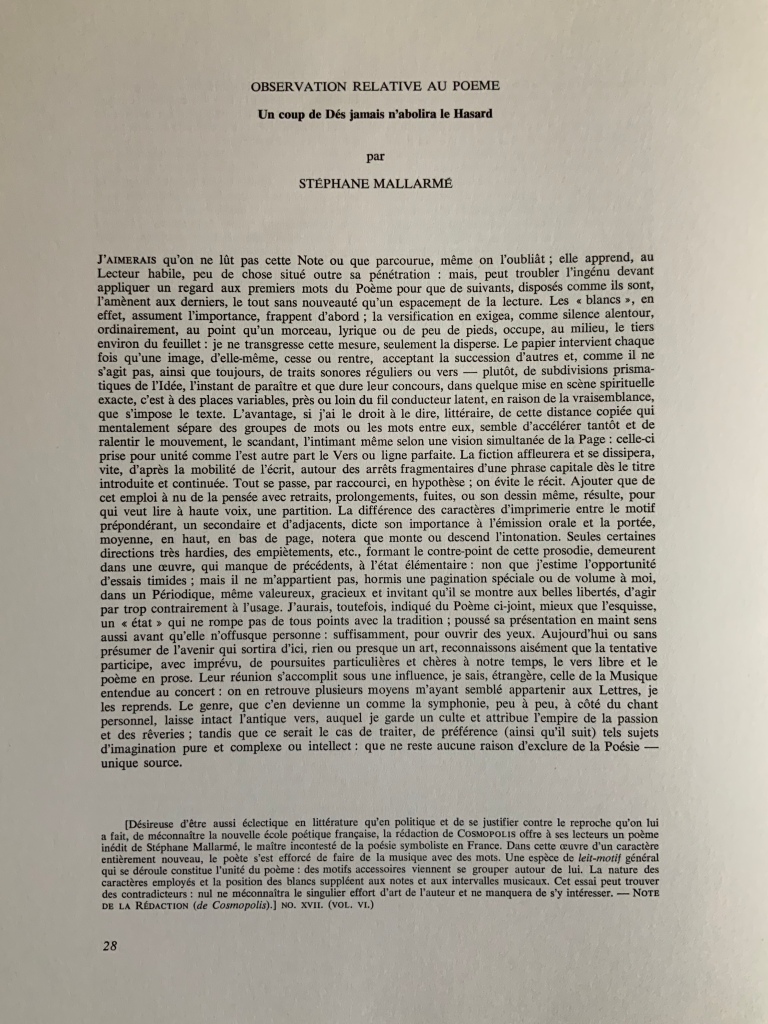Un Coup de Dés Jamais N’abolira le Hasard (1980)

Poème: Un coup de Dés jamais n’abolira le Hasard par Stéphane Mallarmé (1980)
Édition Mise en Oeuvre et Présentée par Mitsou Ronat, Réalisée par Tibor Papp.
Two sets of folded & gathered folios, enclosed in a portfolio with four flaps; Portfolio: H380 x W285 mm; Folios: H380 x W285 mm; Poème, 24 pages, including the cover; “Le Genre …”, 28 pages, not including cover. Acquired from Latour Infernal, 28 May 2020. Photos: Books On Books Collection.
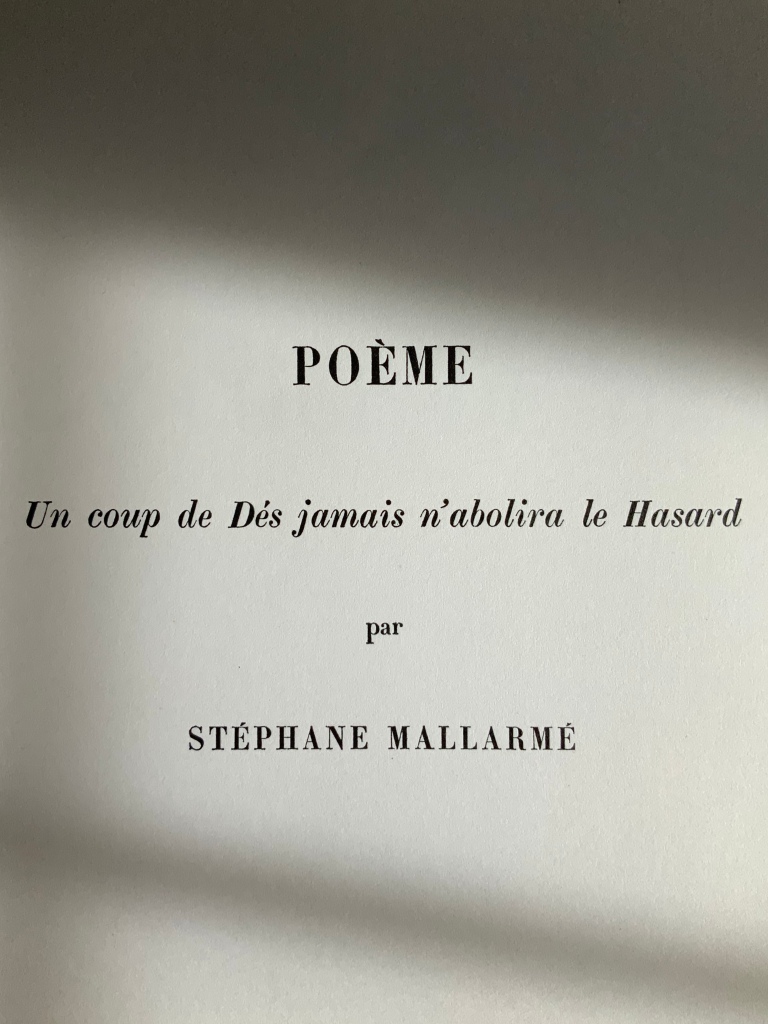
Described as an “édition mise en oeuvre“, the Ronat/Papp 1980 publication of Un Coup de Dés is indeed as much a “production” as any theatrical or cinematic mise en scéne. Equally apropos or more so, the phrase calls to mind the French for page layout: mise-en-page. The layout of the work certainly calls attention to itself as much as to the page. While it represents an effort to reflect Mallarmé’s “true” intentions for the page layout of Un Coup de Dés, the Ronat/Papp production delivers the poem in a set of loose F&Gs (folded and gathered folios), paired with another set of F&Gs (artwork, poems and essays) and enclosed in a portfolio.
The first effort to follow Mallarmé’s intention as intimated in his corrected proofs of the abandoned Ambroise Vollard version was the 1914 NRF edition, which also called attention to itself with its oversized format, but it was sewn and bound into its paper cover as usual. Its lay-flat binding eased reading the lines of verse that run across the book’s gutter.
By unbinding that space that usually sinks into the gutter, Ronat and Papp retain the readability across the gutter but introduce an interesting instability. The unitary view of the double-page spread that Mallarmé intended falls prey to physical chance. Lines across pages can fall out of alignment as folios slip up or down. If the folios scatter, the reordering of the unnumbered pages relies on the guidance of the typography and memory. Oddly this forces a more hands-on engagement with the poem. No other edition intended for reading the poem feels as physical. The page and double-page spreads are felt.
Although also not bound, the order of the artwork, poems and essays in the right-hand set of F&Gs is traditionally fixed with pagination, as the front of its self-covering folio shows. More important is the cover title: “Le genre, que c’en devienne un …” (“the genre, that it becomes one …”). Those words begin the final sentence in the reproduction of Mallarmé’s reluctant note from the poem’s first publication. Cramped into the magazine Cosmopolis, the poem’s layout was still startling enough to the editors to require a preface from Mallarmé. Facetiously and seriously, his note explains how to read the poem. In varied ways, the F&Gs’ content also seriously and facetiously demonstrates how to read the poem. And starting and ending with Mallarmé’s words, the portfolio’s second half reflects the circularity of the poem it faces, which starts and ends with the words un coup de dés. An édition mise en oeuvre indeed.
So forget the debate over who was first to display the poem in the true form as Mallarmé intended. The second portfolio is proclaiming then proving by examples that Un Coup de Dés is a genre.
Mitsou Ronat‘s introduction sets the poem’s publishing history in context and explains this edition’s claim to reflect Mallarmé’s wishes for the poem’s presentation. In doing so, she puts forward her hypothesis that le Nombre (“the Number”) mysteriously posed in the poem is 12, the syllable count of each line in the French alexandrine couplet and ties this revelation to the page and double-page spread as units of meaning, culminating in the 24 pages of which the mise en oeuvre consists. Tibor Papp follows with his map of Déville (“Dice-town”). Overlapping inscriptions along the crisscrossing streets remind us of the sometimes overlooked humor in the Mallarmé industry. One street is labelled Saint-Mallarmé de la masturbation. Off one boulevard are the remparts des alexandrins (“battlements of the Alexandrines”), complete with a WC for passers-by. There is even a Métro stop named for Mallarmé’s Igitur, thematic predecessor to Un Coup de Dés. Another recalls the political cast of the times: premières allusions à la lutte des marginaux oubliées (“first allusions to the struggle of the forgotten marginalized”). But most important is the map as map, a poster, a sub-genre of the genre Un coup de Dés and forerunner to future works such as that by Aurélie Noury. In his essay near the end of the F&Gs, Papp asserts that Mallarmé was not preoccupied with print and typography for its haptic properties, rather he was simply seeking the tools appropriate to complete his text. This is Papp’s departure point for discussing the aims of Le Groupe d’atelier, which he founded with Paul Nagy and Philippe Dôme in 1972:
Pour l’écrivain, donc, d’aujourd’hui, l’attitude de mallarmé scrutant les caractères des affiches, travaillant ses épreuves par collage, déplaçant ses mots d’un millimétre, est une attitude parfaitement normale et logique, en même temps que son poème constitue un classique du genre.
Pour nous, l’écrivain assume son rôle jusqu’à la materialité de son texte.
“For today’s writer, then, the Mallarméan scrutiny of type display, working on his proofs by collage, moving his words by one millimeter, is perfectly normal and logical behavior, at the same time that his poem constitutes a classic of the genre.
For us, the writer’s role entails the materiality of the text.”

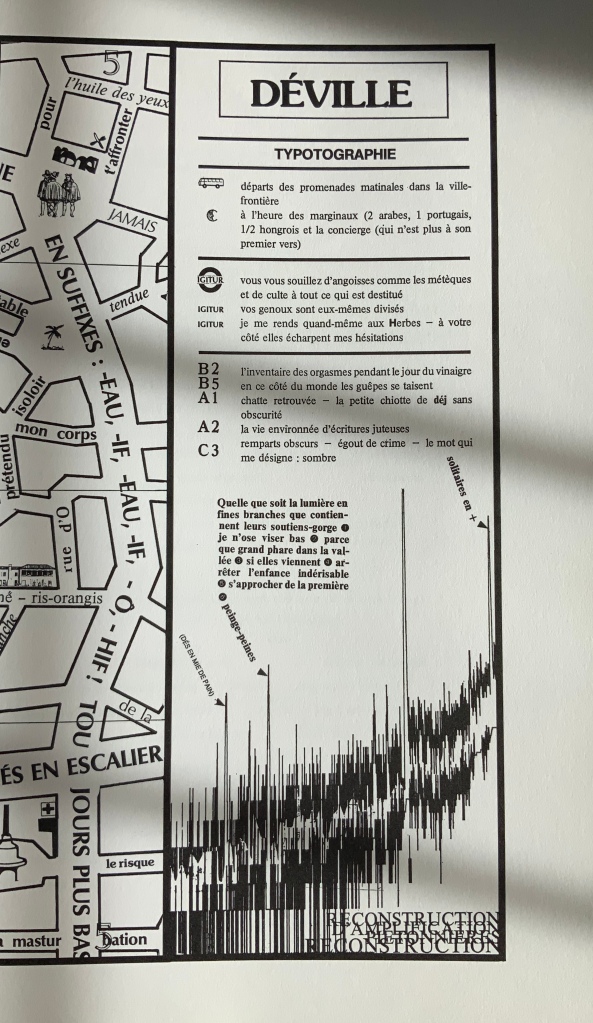

The remaining contributors traverse the ranges of the academic and artistic, the tongue-in-cheek and the serious, that Ronat and Papp establish. A more textual affair, “n’abolira Lazare” by Jacques Roubaud, a member of the OuLiPo movement, delivers an homage to Mallarmé replete with numerical and linguistic puns, appropriate to a professor of mathematics and literature, and a translator of Lewis Carroll. Bruno Montels‘ “Convoquer le peu” displays his signature combination of handwriting and typographic experimentation.
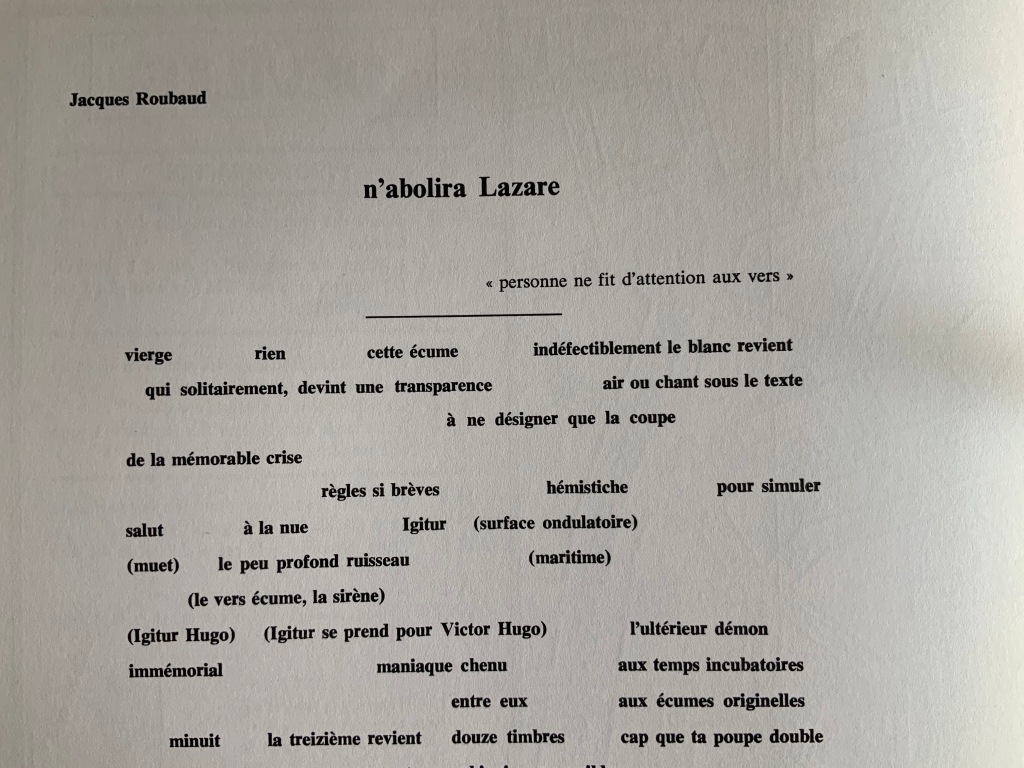
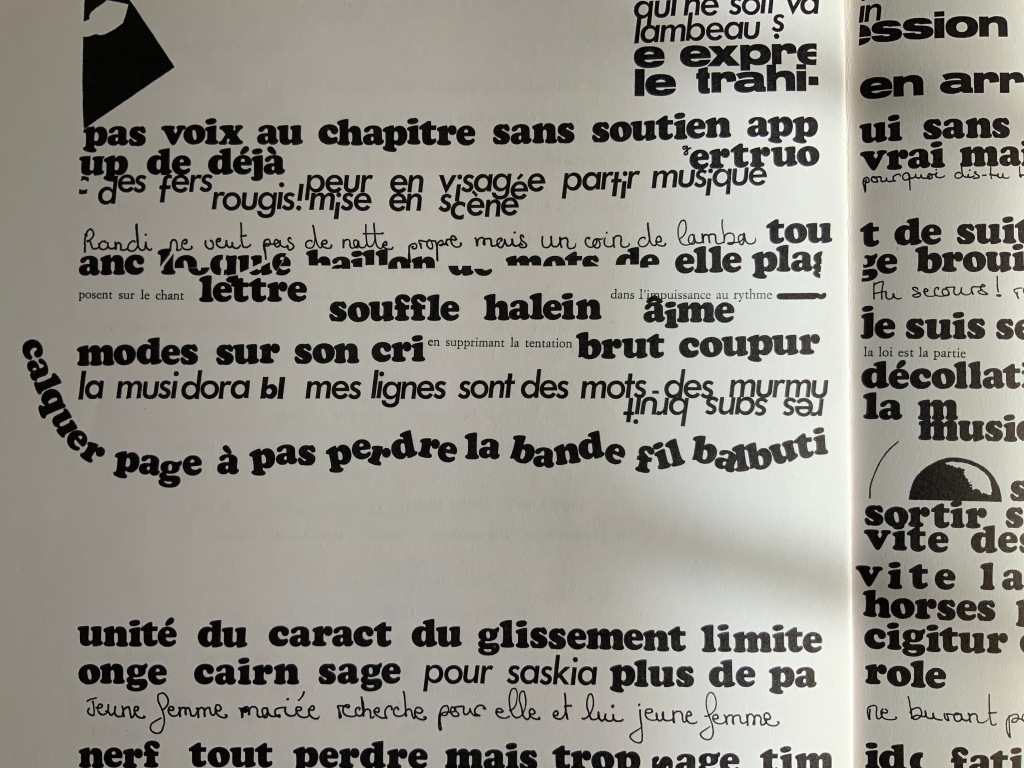
“L’Entre croisement” by Jean Pierre Faye (a visual linguistic pun, “threshold” and “intersection”) reads like notes for an academic lecture but in a free-verse layout. The poet/essayist Claude Minière‘s “Le Risque Picaresque” foreshadows(?) his essay Un Coup de Dés (Tinbad, 2019), which proposes Pascal’s wager and Pensées as a predecessor to Mallarmé.
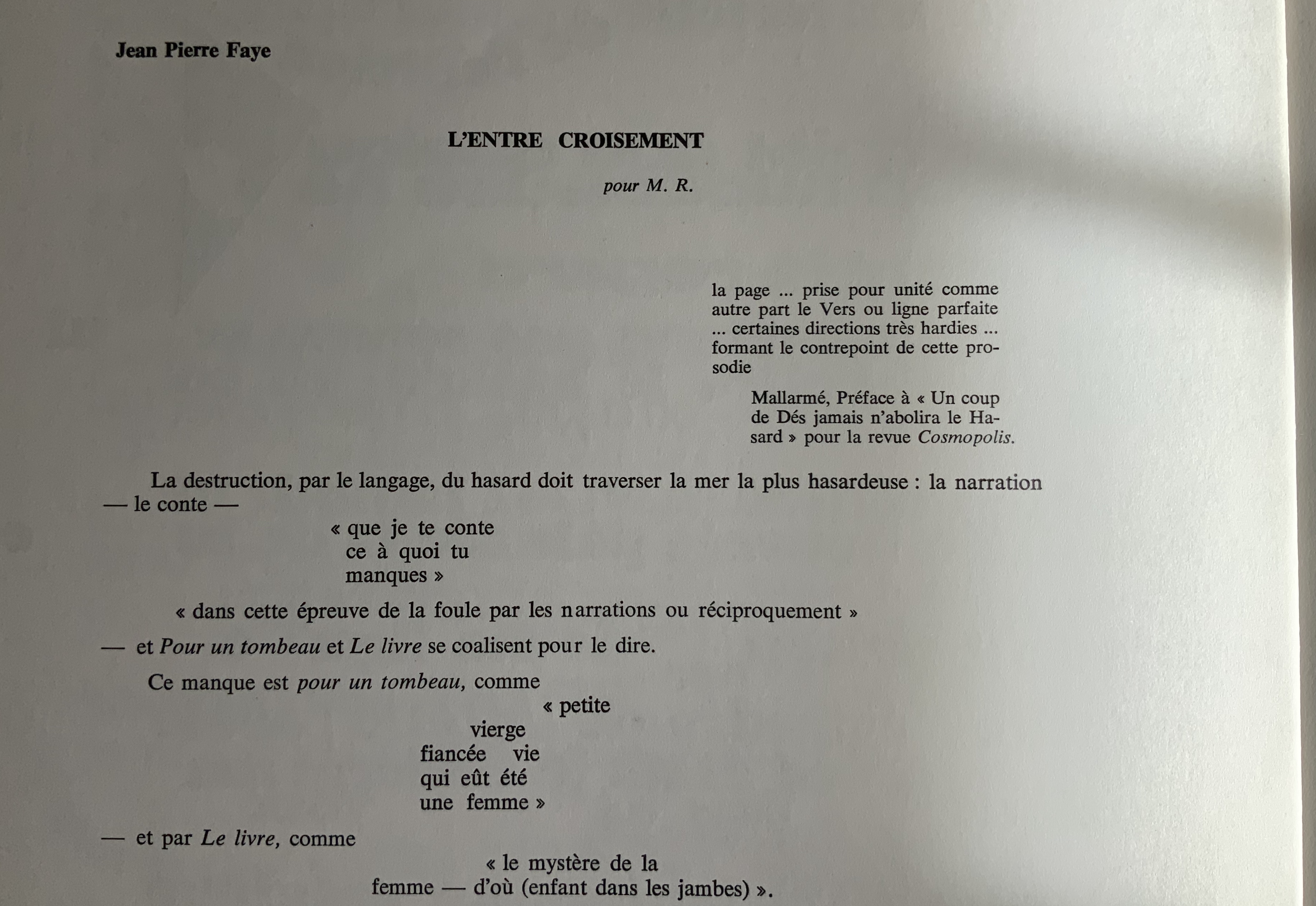

Peruvian poet and writer Rodolfo Hinostroza‘s “Le Dieu de la Page Blanche” (“The God of the Blank Page”) delivers a diagrammatic exploration of the placement of verses on the page in Un coup de Dés, reminiscent of but less abstruse than Ernest Fraenkel’s Rohrschach-like exposition. Philippe Dôme draws on his time as a French and Spanish teacher in London to put together pages of a multilingual study workbook for the reader of Un Coup de Dés. Clearly a lover of puns, he entitles his workbook with Spanish interrogatory marks around the face of a die, the 4 constructed with two colons.
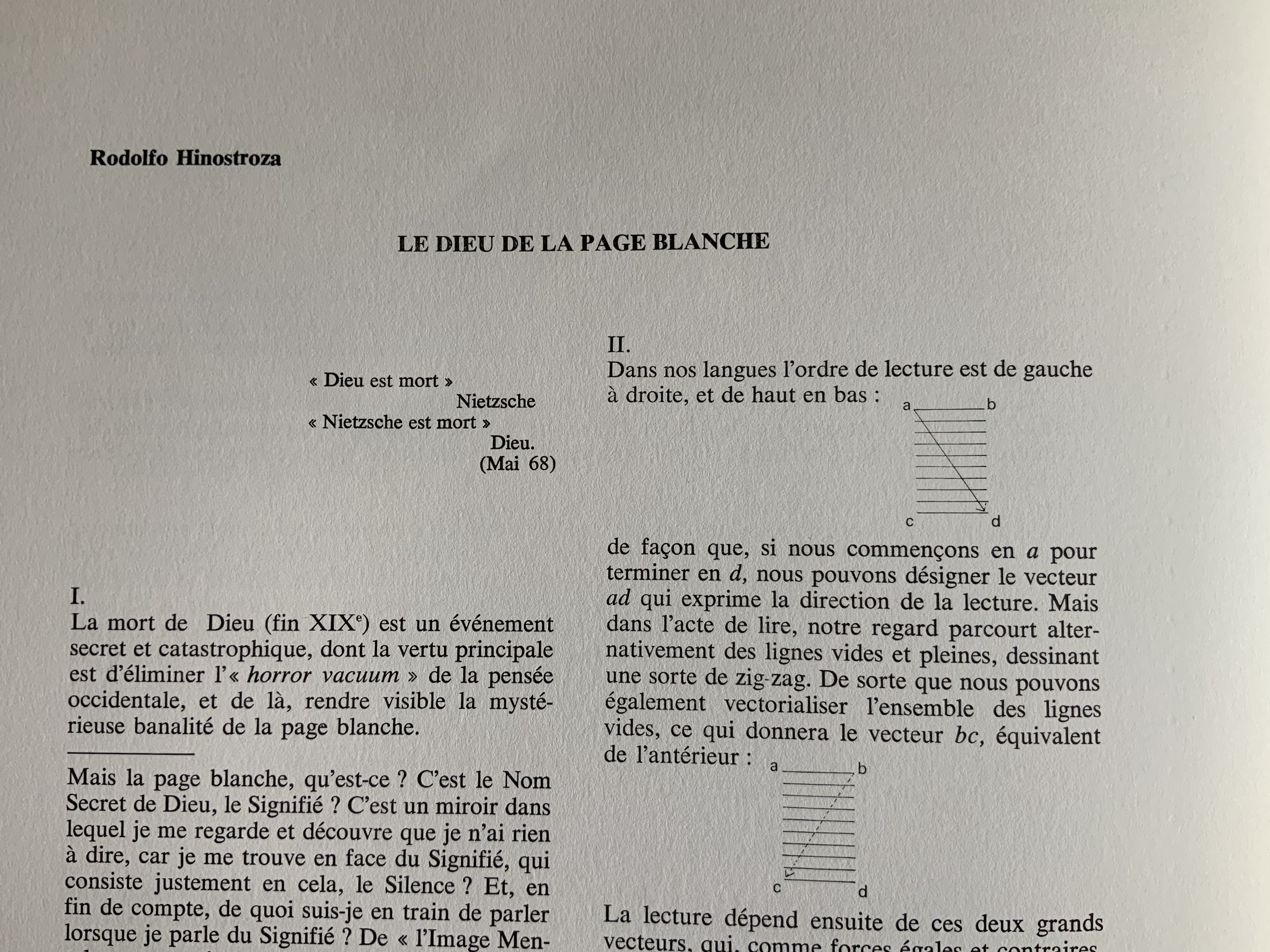

Perhaps the most striking of the visual homages, Paul Nagy‘s contribution is a descendant of Un Coup de Dés by conscious or unconscious way of the earlier typographic and graphic gymnastics of Dada, Marinetti, Iliazd, Gomringer, the Brazilian Noigrandes movement and Fluxus.
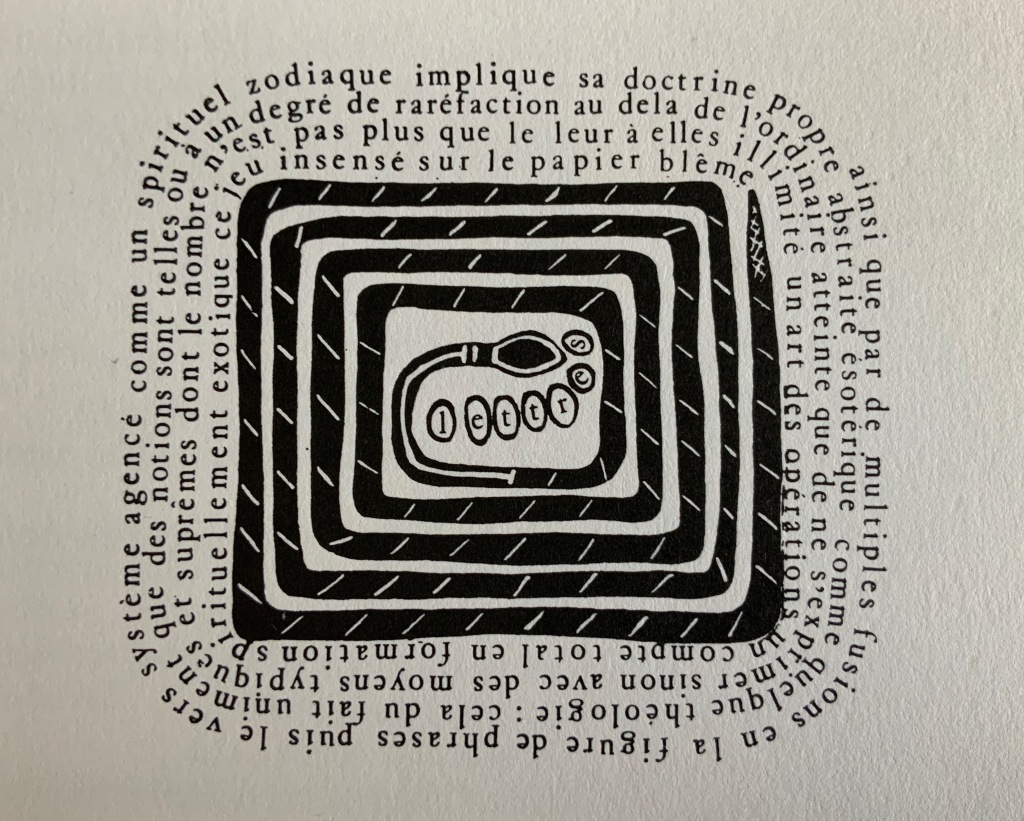
In its unbound folios approach to the poem and juxtaposition of it with artistic interpretations of the poem, the Ronat/Papp production marked a pivot for future treatments of Un coup de Dés. Over the decades after it, three new editions — also aimed at reflecting the Master’s wishes — appeared as did dozens of inventive academic and artistic responses to Un Coup de Dés. The three explorations of the “true” edition (in French) are Michel Pierson‘s (2002), Françoise Morel‘s (2007) and Ypsilon Éditeur‘s (2008). Though the artworks paying homage since 1980 are too numerous to list for this entry, note that Books On Books is preparing a virtual 125th anniversary celebration for 2022 that will display images and links for all the homage paid since 1897 that it has uncovered — from Man Ray’s Les Mystères du Château de Dé (1929) to Sylvain Moore’s Troisième Coup de Dés (2019).
Further Reading
Arnar, Anna Sigrídur. The Book as Instrument: Stéphane Mallarmé, the Artist’s Book and the Transformation of Print Culture (Chicago, IL: University of Chicago Press, 2011).
Fraenkel, Ernest. Les Dessins trans-conscients de Stéphane Mallarmé : à propos de la typographie de “Un Coup de dés” (Paris: Nizet, 1960).
Meillassoux, Quentin. The Number and the Siren (2012). Meillassoux argues the toss with Ronat over the identity of le Nombre.
Moulinier, Didier. “Pour une histoire de la poésie concrète“, La Poèsie Élèmentaire, 5 March 2011. Accessed 5 November 2020.
Stark, Trevor. Total Expansion of the Letter: Art and Language after Mallarmé (Cambridge, MA: MIT Press, 2020).

